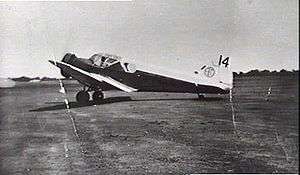Airspeed Courier
The Airspeed AS.5 Courier was a British six-seat single-engined light aircraft that saw some use as an airliner. Production aircraft were built by Airspeed (1934) Limited at Portsmouth. It first flew on 10 April 1933 and was the first British type with a retractable undercarriage to go into production, with a total of 16 built.
| AS.5 Courier | |
|---|---|
 | |
| Airspeed Courier A5.5 G-ACJL, pictured on 1934 MacRobertson England - Australia Air Race | |
| Role | 5/6-seat light transport |
| Manufacturer | Airspeed |
| Designer | A. H. Tiltman |
| First flight | 10 April 1933 |
| Primary user | London, Scottish & Provincial Airways Ltd |
| Number built | 16 |
Development
The prototype Courier was designed by Hessell Tiltman (co-founder of Airspeed Limited) and was built in 1932 by Airspeed at York for an attempt by Sir Alan Cobham to carry out a non-stop flight to India, using airborne refuelling. Airspeed moved from York to Portsmouth before the Courier G-ABXN first flew on 10 April 1933. The Courier was a wooden low-winged cabin monoplane; it had a novel feature for the day of a retractable undercarriage. The prototype was powered by an Armstrong Siddeley Lynx engine. The prototype had two minor accidents, in April 1933 at Portsmouth and in June 1933 at RAF Martlesham Heath. The aircraft was repaired on both occasions.
After a year spent perfecting airborne refuelling, Alan Cobham took off from Portsmouth in the prototype Courier on an attempted flight to India on 24 September 1934, being refuelled from a Handley Page W.10 before making a forced landing at Malta due to a broken throttle.
Production and operations
A production run of 15 Couriers followed during 1933/34, being used for air-racing (one finished sixth in the MacRobertson Air Race to Australia in 1934), and as a light airliner and for air taxi work.
Shute wrote in Slide Rule [1] that six Couriers came back to the company when their operating company suspended operations but shortly after that the Spanish Civil War broke out and the machines all sold immediately to various intermediaries for better than the original prices, and all went by devious routes to Spain. He had got a reputation as unscrupulous for resisting the auditors’ attempt to write their value down on the books; see Airspeed Ltd.
In 1936 a gun-running organization, Union Founders' Trust, bought five Couriers with the intention of selling them for use by the Republicans in the Spanish Civil War. However, protests from the non-interference lobby in England stopped delivery. Two Republican sympathisers on the Airspeed staff made an abortive attempt to steal G-ACVE. One of them, Arthur Gargett, died when it crashed after taking off at Portsmouth on 20 August 1936; the other, Joseph Smith, was sentenced to four months in prison.[2]
Owing to its advanced aerodynamics, two were used as research aircraft, one by the Royal Aircraft Establishment and one by Napier's, who used it for development of the Napier Rapier engine.
At the outbreak of the Second World War, the majority of the surviving Couriers were impressed into the RAF, who used them for communications purposes. Only one Courier survived the War, being used for joyriding at Southend-on-Sea before being scrapped in December 1947.
Variants
- AS.5 Courier
- Prototype - 240 hp (179 kW) 240 hp Armstrong Siddeley Lynx IVC
- AS.5A Courier
- Main production type - 240 hp (179 kW) Armstrong Siddeley Lynx IVC
- AS.5B Courier
- Fitted with more powerful 277 hp (207 kW) Armstrong Siddeley Cheetah V engine. Two built.
- AS.5C Courier
- One aircraft, registered G-ACNZ was bought as an engine testbed by Napier - Powered by 325 hp (242 kW) Napier Rapier IV engine.
Accidents and incidents
On 29 September 1934, G-ACSY of London, Scottish & Provincial Airways Ltd crashed at Shoreham, Kent, United Kingdom, killing all four people on board and injuring two on the ground.
Operators
- Air Taxis Ltd
- Channel Airways
- Cobham Air Routes
- London, Scottish & Provincial Airways
- North Eastern Airways
- Air Transport Auxiliary
- No. 3 Ferry Pilots Pool
- Royal Air Force
Specification

Data from British Civil Aircraft since 1919[3]
General characteristics
- Crew: 1
- Capacity: 5 passengers
- Length: 28 ft 6 in (8.69 m)
- Wingspan: 47 ft 0 in (14.33 m)
- Height: 8 ft 9 in (2.67 m)
- Wing area: 250 sq ft (23 m2)
- Empty weight: 2,344 lb (1,063 kg)
- Gross weight: 3,900 lb (1,769 kg)
- Powerplant: 1 × Armstrong Siddeley Lynx IVC air-cooled 7-cylinder radial engine, 240 hp (180 kW)
Performance
- Maximum speed: 153 mph (246 km/h, 133 kn)
- Cruise speed: 132 mph (212 km/h, 115 kn)
- Range: 635 mi (1,022 km, 552 nmi)
- Service ceiling: 13,500 ft (4,100 m)
- Rate of climb: 730 ft/min (3.7 m/s)
See also
Related lists
- List of aircraft of the RAF
References
- Norway 1954, pp. 204-208.
- Howson, Gerald (1998): Arms for Spain: The untold story of the Spanish Civil War, John Murray
- Jackson 1973, pp. 18–19
- Jackson, A. J. (1973). British Civil Aircraft since 1919 Volume 1 (2nd ed.). London: Putnam. ISBN 0-370-10006-9.CS1 maint: ref=harv (link)
- Norway, Neville Shute (1954). Slide Rule. London: William Heinemann.
External links
| Wikimedia Commons has media related to Airspeed AS.5 Courier. |